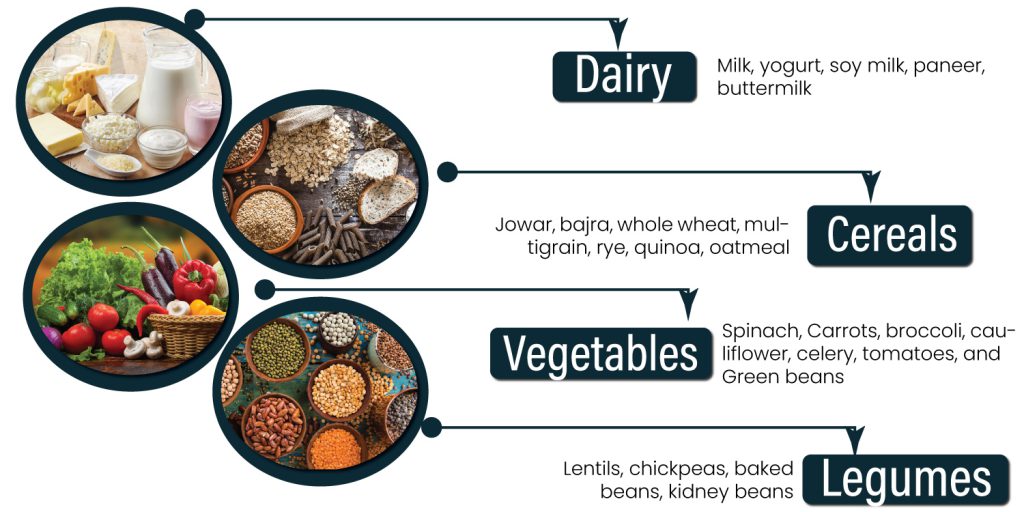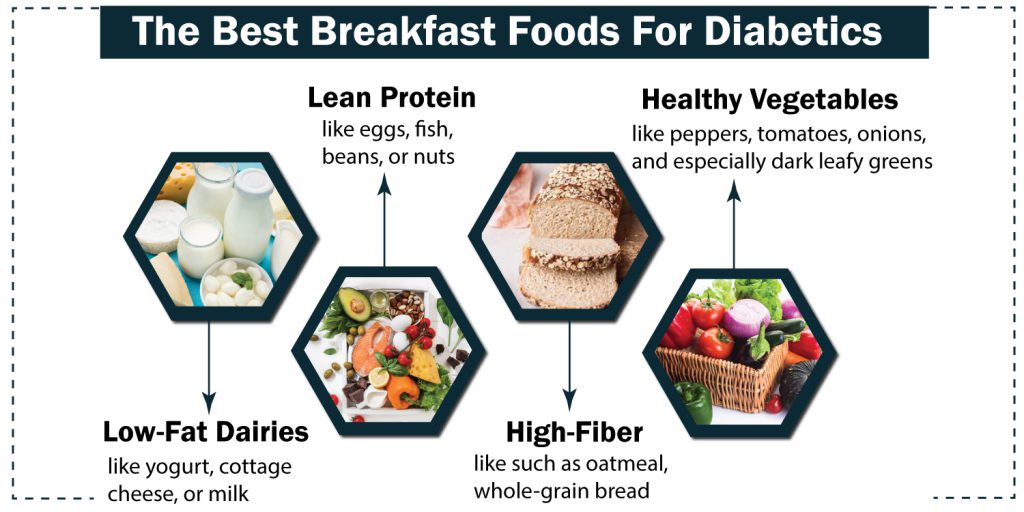Diabetes can be well controlled if one knows exactly what foods diabetics can eat. As soon as you’ve been diagnosed with type I or type II diabetes, you should start paying attention not only to what foods diabetics can not eat but also to your glucose levels.
Food is broken down into glucose, which is then used to fuel our cells. Insulin is a pancreatic hormone that assists in the transport of glucose into cells for utilization. Both type-1 and type-2 diabetes differ in nature.
- Type 1 diabetes arises from poor insulin production.
- Type 2 diabetes arises from insulin resistance
In either case, eating well is the key to living a healthy and long life for diabetic patients.
But, What does it mean to eat well, though? What foods diabetics can eat without restriction? This blog has the answers to all of these questions and more.
What are the First Signs of being Diabetic?
When we think of diabetes, one of the first questions that pop to us is what are the early signs of diabetes? Below we have listed all the common symptoms of type-1 and type-2 diabetes.
Type 2 Diabetes
Diabetes is influenced by age, weight, a sedentary lifestyle, and family history. Your pancreas produces less insulin if you have type 2 diabetes. Your body, on the other hand, is unable to utilize insulin efficiently. As a result, blood glucose does not enter cells and remains in the bloodstream. Some of it is excreted in urine by the kidneys.
Unfortunately, approximately 50-60% of patients may be asymptomatic. Others may exhibit diabetes symptoms such as weight loss, increased urine frequency, increased thirst/appetite, genital fungal infections, weariness, and so on.
Early signs of type 2 diabetes include:
- Slow healing of cuts and wounds
- Increased hunger
- Nerve pain or numbness
- Blurred vision
- Dark skin patches
Unusual Symptoms of Diabetes
Diabetes might go unnoticed for years before it manifests. By keeping an eye for the uncommon symptoms you can not only manage diabetes but also reverse it. Here are a few odd or unusual symptoms of diabetes.
- Unexplained weight loss
- Restlessness
- Sleep disturbance (too much or too less sleep)
- Intolerance to change in temperature and climate
- Numbness in fingers and toes
- Swelling in legs
- Unexpected hair loss
According to the American Diabetes Association, anyone with a BMI of more than 25 and at least one additional risk factor, such as a family history of diabetes, hypertension, Asian ancestry, physical inactivity, PCOD, or low HDL and high TG, should be tested for diabetes.
So don’t wait for diabetes symptoms type 2 to arrive. Determine your risk and get tested. Type 2 diabetes can often be avoided by following a few simple steps, such as losing weight, exercising more, eating a healthy diet, and not smoking.
Type 1 Diabetes
Type 1 diabetes, often known as juvenile or childhood diabetes, is a chronic condition. In children with type 1 diabetes, the pancreas does not make insulin. Insulin is a hormone that helps glucose enter cells and be converted into energy.
Symptoms of childhood diabetes or type 1 diabetes can come on suddenly and include:
- Increased thirst and frequent urination
- Severe hunger
- Dry mouth and itchy skin
Other symptoms of childhood diabetes(type 1) include:
- Unintended weight loss
- Sudden bed-wetting in children
- Irritability and mood swings
- Fatigue and weakness
- Blurry vision
Why do People get Diabetes and foods diabetics can eat?
Diabetes is anticipated to affect 643 million by 2030 and 783 million by 2045. Diabetes is spreading at a frenetic pace. The question is why is diabetes so common among adults and children nowadays.
The following are the main reasons:
- Obesity
- Lack of exercise
- Unhealthy lifestyle
- Increase in stress levels
- Eating too much sugar and processed carbohydrate
How Fast does Diabetes Develop?
Type 1 diabetes can develop rapidly and without warning, sometimes within a few weeks. Type-2 diabetes, on the other hand, does not appear suddenly. However, the diabetes symptoms may not always have to be visible. Many people with type 2 diabetes exhibit no specific symptoms.
Best Food for Diabetic
Diet plays such a crucial role in diabetes prevention and management. Knowing how much to eat and when to eat is important. Keeping a track of calorie intake will help maintain health, improve overall well-being, and prevent future complications.
Why do Glycemic Index (GI) and Glycemic Load (GL) Matter?
The glycemic index (GI) is a number that indicates how much a particular item raises blood sugar levels. Depending on the glycemic level, foods diabetics can eat are classified as low, medium, or high.
- Low GI index: 1 to 55.
- Medium GI index: 56 to 69.
- High GI index: 70 and higher.
- Foods with lower GI are least likely to spike blood sugar levels.
Along with GI, it is also important to take into account glycemic load (GL). GL measures how much a food boosts a person’s blood glucose level after they eat it.
The glycemic load of food varies depending on portion size, with a range of values ranging from 0 to 35. Anything higher than 15 is off-limits. Here’s a simple guideline to follow:
- Low GL – a score of ten or less is excellent
- Medium GL – 11-14 is OK
Here are some of the low glycemic index (GI) foods diabetics can eat. These food items can easily be included in the diet of diabetics –

- Cereals: Jowar, bajra, whole wheat, multigrain, rye, quinoa, oatmeal, rolled oatmeal, steel-cut oatmeal, and oat bran are all low GI foods, with a GI value of 55 or less.
- Vegetables: Spinach, Carrots, broccoli, cauliflower, celery, tomatoes, and Green beans
- Legumes: Lentils, chickpeas, baked beans, kidney beans
- Dairy: Milk, yogurt, soy milk, paneer, buttermilk
What Fruits and Foods Diabetics can Eat Freely?
If the fruit tastes extremely sweet, it contains sugar. Diabetics can eat any fruit except bananas, mangos, custard apples, and jackfruits. The rule is to watch out that fewer amounts are eaten at the right times. Fruit is generally not recommended after 5:00 / 5:30 p.m.
Here’s a list of the best fruits that diabetics can eat freely:
Low GI Fruits (GL under 10)
- Berries
- Cherries
- Plums
- Grapefruit
- Peaches
- Kiwi
- Apple
- Oranges
- Apples
- Avocados
Best Foods Diabetics Can Eat in Breakfast
As a diabetic, the first meal of the day is the most important. It makes a person feel full and helps to maintain blood glucose levels. It’s best to have breakfast and avoid eating late at night because insulin sensitivity is often higher in the morning than in the evening.
Moreover, the meals should be low on carbs and high on protein. Protein-rich and low-card foods are the best foods diabetics can eat. They promote fullness and reduce hunger. As a result, calorie consumption is lower 24 hours after breakfast.
The best breakfast foods for diabetics comprise four key ingredients. These include:

- Lean protein like eggs, fish, beans, or nuts
- High-fiber like such as oatmeal, whole-grain bread
- Low-fat dairies like yogurt, cottage cheese, or milk
- Healthy non-starchy vegetables like peppers, tomatoes, onions, and especially dark leafy greens
Can Diabetics Eat Meat Freely?
Diabetes patients can consume lean meat and fish. But they are not the ideal foods diabetics can eat. To reduce the risk of high cholesterol and heart disease, however, consumption should be kept to a minimum.
Is Falling a Sleep after Eating a Sign of Diabetes?
It’s not uncommon to feel sleepy after eating. You do not have Diabetes Mellitus if your only symptom is sleepiness after a large meal.
But it could also indicate that you are pre-diabetic. If you have other diabetes symptoms or if you want your glucose checked for screening purposes, you should get a fasting blood glucose test.
Conclusion
Anyone who has any of the above diabetes symptoms should contact a doctor as soon as possible, regardless of whether or not they have diabetes, as they may have diabetes without realizing it.
The sooner someone begins to manage high blood sugar, the greater their chances of decreasing its progression and complications. To effectively control diabetes, a person must keep track of the number of calories they consume each day.
The tracking can feel difficult to manage at first. This is where the work of a diabetic expert and dietitian is critical. They help patients with the perfect diet plan including only the best foods diabetics can eat. Kayawell is an online platform that connects doctors and patients. With just a few clicks diabetic patients can find the best dietitian for diabetes near them. Visit Kayawell for the perfect Diabetes reversal plan today.

Leave a Reply
You must be logged in to post a comment.